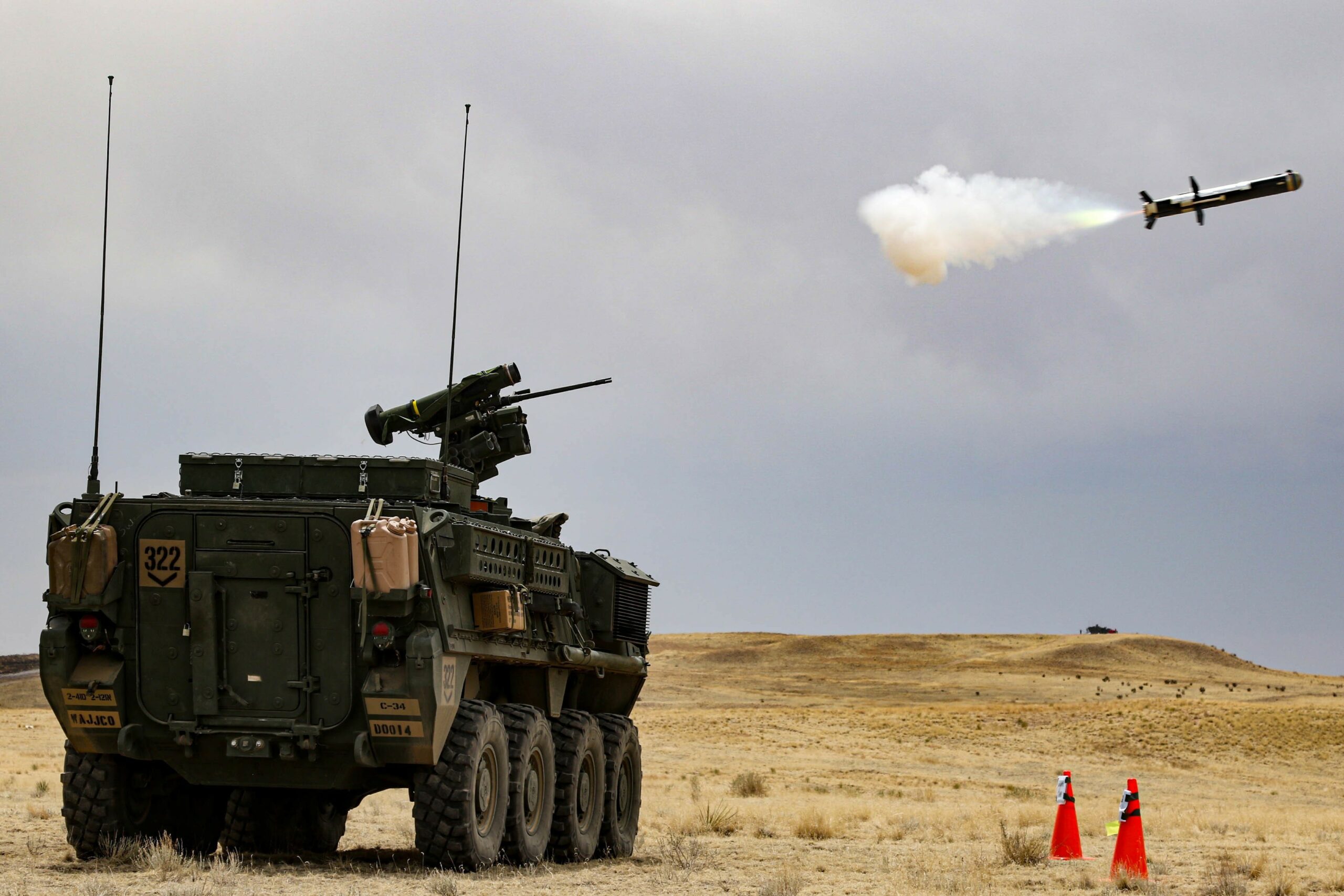Global market surveys forecast continued high demand for anti-tank guided missiles (ATGMs) over the next decade.
While insurgencies and low-intensity conflicts are here to stay, the world is experiencing a return to great power conflict and interstate warfare. With the increasing prospect of combat involving armoured formations, national armed forces need to reinforce their capability to defeat main battle tanks (MBT) and other heavy or medium-armoured vehicles. The ongoing war in Ukraine is a prime example of the new security environment. According to analyses by the (now defunct) Dutch open-source intelligence service Oryx, Russia lost some 1,000 tanks (and up to 9,000 vehicles total) during just the first year of the war. Ukraine, which entered the conflict with considerably smaller forces, is estimated to have lost 460 tanks during the same period. These statistics include losses from tank and artillery fire, rocket-propelled grenades (RPG), unmanned aerial vehicles (UAVs), loitering munitions, and mines. Nonetheless, a significant portion of the destroyed tanks were neutralised by anti-tank guided missiles (ATGM), highlighting their importance as part of a cohesive anti-armour strategy.

Credit: US Army
While the various ATGM market analyses diverge with regard to specific numbers, studies such as the Insight Partners Report (2020–2031), Technavio Report (2022–2027), Research and Markets Report (2023–2024), and IMARC Group Analysis (2024–2032) all agree that demand growth will remain strong in every major global region. Projected compounded annual growth rates (CAGRs) vary between 3.1% and 4.7% over the studies’ respective timeframes. Again, with slight deviations, the studies suggest a 2023 ATGM global market value of approximately USD 3 billion. Technavio estimates that this market segment will increase by USD 472.45 million by 2027, while the IMARC Group’s analysis forecasts that global sales will reach USD 4.2 billion by 2032. North America remains the largest regional market, followed by Europe and the Asia-Pacific region in approximately equal measures. Major drivers here are the increased threat perception from Russia, China and North Korea respectively, with the United States, ‘NATO Europe’, South Korea and Japan reacting to this threat. In the case of the US and Europe, the need to replenish stocks transferred to Ukraine will force short-to-medium term investment over-and-beyond previously planned acquisitions.
ATGM attributes
ATGMs have several advantages, including flexibility, precision, accuracy, and portability. They are comparatively low-cost weapons, permitting acquisition of large stockpiles with which to attack very high-cost MBTs and other armoured vehicles. Their small size and easy handling mean they can be fired from cover. They can also be deployed by dismounted infantry (shoulder-fired or tripod-mounted) or mounted on a wide range of platforms from light vehicles to MBTs. Helicopters, strike UAVs, and manned or unmanned boats can carry them as well, maximising the potential angles of attack. While designed primarily to attack MBTs and other armoured fighting vehicles, they can also be deployed against bunkers and other hardened targets, against soft targets such as above-ground fuel and ammunition stores or parked aircraft, and even against low-flying helicopters.
When compared to RPGs, ATGMs have greater range and the ability to manoeuvre in flight, with some able to follow a lofted trajectory to execute top-down attacks against the weaker roof armour seen on most armoured platforms. Guidance and targeting systems typically use either homing guidance, typically employing an infrared (IR) seeker, or semi-automatic command to line-of-sight (SACLOS) guidance, such as laser beam-riding or wire-guided (fibre-optic). A large percentage of modern ATGMs are ‘fire-and-forget’ weapons, which permit crews to relocate immediately after initiating the attack. Training soldiers to operate them is comparatively simple. SACLOS weapons, on the other hand, require the shooter – whose whereabouts have been exposed – to remain in position until impact on target. The shooter (or the weapon platform) remains vulnerable to counterattack; on the other hand, wire-guided and laser beam-riding missiles are often immune to many forms of electronic jamming or dazzling, and difficult to misdirect through obscurants.
Range varies widely, with most ATGMs reliably destroying targets which are approximately 3-8 km away; and longer-range non-line-of-sight (NLOS) versions allow engagement at ranges of 30 km or even more. With regard to warheads, most ATGMs are equipped with either a unitary high explosive anti-tank (HEAT) charge or a tandem-HEAT charge.
Modern anti-tank weapons
ATGMs are developed and built in many nations. Numerous projects to develop new, technologically advanced weapons – or to upgrade older systems – are ongoing. However, some remarkably old designs continue to perform at the highest levels.
FGM-148 Javelin
The FGM-148 Javelin entered service with the US armed forces in 1996, and has been continually upgraded since then. It is currently operated by 24 nations including Ukraine, which by its own claims was firing up to 500 Javelins daily during the early phase of the war. According to the US Army, the fire-and-forget Javelin is designed to defeat all known and projected threat armour, using direct or top-down attack profiles, at up to a range of 4 km. It utilises an onboard imaging infrared (IIR) seeker and a tandem-HEAT warhead. The ‘soft launch’ system ejects the Javelin from the missile tube, and ignites the main engine once the projectile is a safe distance from the operator, serving to protect personnel from potential injury. Target detection, identification and selection are performed via the detachable Command Launch Unit (CLU) using day and IR channels, with various magnification levels. The targeting data is fed into the missile’s guidance system via the launch tube assembly interface, and the missile is launched.

Credit: US Army
The FGM-148 is produced by the Javelin Joint Venture, a collaboration between Lockheed Martin and RTX. Current upgrades include a lightweight CLU (LWCLU) with smaller dimensions and improved battery life (first deliveries expected in 2025); a multipurpose warhead (MPWH) which retains full anti-armour capability but adds a fragmenting steel case to improve performance against personnel and light vehicles (entered production in 2020 as the FGM-148F); and the FGM-148G which will have a new launch tube assembly, battery and guidance unit. A production decision on the FGM-148G has been delayed due to software issues. Barring further complications, the Army now expects to field first units in FY 2025. Independent of ‘G-model’ development, the Javelin Joint Venture is currently aiming to ramp up annual production rates from 2,100 missiles in 2022 to a target of 3,960 units by late-2026. Aside from these developments, Javelin is expanding beyond being a strictly man-portable system; since 2021, the missile has been successfully launched from the JLTV, the Stryker 8×8, and various unmanned platforms.
BGM-71 TOW
The BGM-71 TOW (Tube-launched, Optically-sighted, Wire-guided) entered service in 1970. Originally developed by Hughes Aerospace, it is now manufactured by RTX. More than 700,000 units have been delivered to date, equipping the forces of over 40 nations. Since SACLOS wire-guided systems require a stable platform for weapon control, the BGM-71 is usually either tripod-mounted or launched from a vehicle or helicopter. Vehicle mounts can consist of a single pedestal mount, a twin-tube or a four-tube configuration; moreover, the crew can launch while under armour.

Credit: US Army
Contemporary anti-vehicle variants include the BGM-71E, also known as TOW 2A, which has a range of 3,750 m and carries a tandem-HEAT warhead that has demonstrated penetration of up to 1,000 mm of rolled homogenous armour equivalent (RHAe); and the BGM-71F, also known as the TOW 2B Aero, which has a range of 3,750 m and carries two Tantalum explosively formed penetrators (EFPs). The latter missile uses an overfly top attack (OTA) profile; instead of directly impacting the target, the missile flies over the target. When the Thales dual-mode sensor detects the target, it activates both EFPs simultaneously, one firing directly downward and one at a slight angle to increase the odds of successful penetration. The RF variants of both (TOW 2A RF and TOW 2B RF) replace the wire guidance with a one-way radiofrequency link, but still requires the operator to actively guide the missile to target. In the case of the TOW 2B RF variant, missile range is increased to 4,500 m.
Close-Combat Missile System – Heavy (CCMS-H)
Despite ongoing modernisation and upgrading of the BGM-71 TOW, the US Army plans to replace it with a new weapon in the 2028–2032 timeframe. The US Army’s Program Executive Office Missiles and Space issued a Request for Information (RfI) in 2022, with a focus on current production, production representative, or prototype systems satisfying specific CCMS-H characteristics. These characteristics include manoeuvrability to engage and defeat Tier 1 armoured threats (defined as high-priority adversary armoured vehicles) and field fortifications.
The future weapon must have dual command-guidance options which could include fire-and-forget, command-to-line-of-sight (CLOS), or semi-active laser (SAL) homing. The weapon must also be reprogrammable in flight, enabling the crew to change targets at short notice. It must have similar dimensions to the current TOW, and be mountable within the same space constrictions. According to the RfI, “CCMS-H should maintain a minimal range of 65 meters, direct fire range of 4500 meters, and a cooperative engagement enabled range of equal to or greater than 8000 meters while maintaining a parabolic arc below 3000 feet [914 m] above ground level (AGL).”
The missile is also required to fly faster than TOW, with the RfI stating that, “CCMS-H should reduce engagement time to 4,000 meters as compared to current capabilities.” Additionally, targeting cues must be accepted from a variety of sources including off-board laser designators or drone feeds, and an autonomous target search and lock-on capability is also desired. It must be able to defeat enemy vehicles’ soft-kill and hard-kill active protection systems (APSs). To date, the Pentagon has not released information regarding industry responses to the RfI, nor has a target date for a Request for Proposals been revealed.
Pars 3 LR
Several advanced European systems have entered the market within the past decade. These include the Panzerabwehrraketensystem 3 LR (PARS 3 LR), also known as third-generation anti-tank – LR (TRIGAT-LR), produced by the Parsys GmbH, a joint venture between MBDA Deutschland GmbH and Diehl Defence.

The fire-and-forget IR homing ATGM is designed exclusively for helicopter carriage, and is equipped with a tandem-HEAT warhead, capable of engaging heavily-armoured targets out to ranges of 7 km. The helicopter platform can launch a salvo of four ATGMs in under 10 seconds, then change positions to avoid counterattack while the missiles autonomously home in on their designated targets.
The German Army acquired 680 units in the 2012–2014 timeframe to arm the Tiger attack helicopter. Indonesia is currently the only export customer, with deliveries of 700 missiles beginning in 2018.
Akeron MP
The Akeron MP medium-range ATGM (formerly known as the Missile Moyen Portée (MMP)), produced by MBDA France, entered service with the French armed forces in 2018. Although initially fielded as an infantry-portable weapon, the missile is also equipping various French armoured fighting vehicles being procured under the SCORPION programme.
The missile has a range of 4 km, and is equipped with a dual-band seeker with uncooled IIR and day TV cameras, a tandem-HEAT multipurpose warhead with selectable effects to optimise performance against armoured vehicles or buildings, as well as a fibre optic datalink, and multi-mode guidance algorithms. Operators can select either fire-and-forget or human-in-the-loop operating modes, the latter of which allows the missile to be re-targeted, a specific aim point selected, or mission abort during flight.
The missile can also follow a direct fire or lofted trajectory, the latter allowing top-attack engagements to take place. Additionally, the missile is capable of two engagement modes: lock-on before launch (LOBL), and lock-on after launch (LOAL). This flexibility allows the gunner to engage targets outside of their direct line-of-sight (LoS), such as tanks sheltering behind cover. The missile uses a soft-launch system, making it safe to fire from confined spaces. According to MBDA, the tandem-HEAT warhead is capable of defeating “all generation ERA” and penetrating up to 1,000 mm of RHAe, or around 2,000 mm of concrete.

Credit: MBDA
MBDA has also developed the Akeron LP which will arm French and Spanish Tiger Mk III attack helicopters. This missile has a longer maximum range than Akeron MP, listed as 20 km by MBDA, which is understood to be the missile’s maximum air-launched range. The Akeron LP has a three-mode seeker (uncooled IR, day TV, and SAL) and a bidirectional RF datalink.
NLAW
The Next generation Light Anti-tank Weapon (NLAW) developed by Saab is designed to combine portability and firepower.
While this is not an ATGM, due to the fact that the weapon is not guided in flight, it is nonetheless capable of engaging moving targets due to its predicted line-of-sight (PLOS) targeting system. With PLOS, the operator tracks the moving target for a few seconds before launching. Once launched, the missile’s on-board guidance system records the aiming motion of the soldier and autonomously calculates the required flight path. Once launched, the missile flies along its calculated trajectory unguided. Due to the relatively short effective range of 20 m to 800 m, and hence short flight times, the chances of successfully hitting the target are fairly high. The user can select from overfly top attack (OTA) mode for use against armoured vehicles, or direct attack (DA) mode for use against structures or soft targets. The warhead is initiated by a dual-mode laser/magnetic proximity fuze in OTA mode, or by an impact fuze in DA mode.
The maximum range is fairly short compared to ATGMs, but at only 12.5 kg, the weapon is fairly light, allowing a single soldier to deploy the weapon within seconds of detecting a target, and its soft-launch mechanism allows it to be launched from confined spaces such as the interior of buildings. The manufacturer stresses that it is designed to attack from almost any position, from basements to second-storey windows or rooftops, enabling shooters to assume less predictable positions. According to Saab, the unitary HEAT warhead can penetrate over 500 mm of RHAe, which when directed against the weaker roof armour in OTA mode, is sufficient to defeat MBTs and other heavily protected vehicles. Additionally, OTA mode allows for engaging armoured vehicles behind some forms of cover, such as a wall. Although NLAW entered service in 2009, its versatility has ensured that is has remained a reliable short-range anti-tank capability for infantry.
UMTAS
Roketsan’s UMTAS (also known as ‘Mizrak-U’) ATGM is designed to equip light aircraft, helicopters, UAVs, an array of vehicles, and watercraft. The weapon has a maximum range of 8 km, and is provided with a tandem-HEAT multipurpose warhead to combat MBTs and other heavily armoured vehicles, with an optional thermobaric warhead offered for engaging structures and soft targets. The UMTAS was understood to have completed qualification and entered service with the Turkish Armed Forces in 2018.

Credit: Roketsan
The baseline UMTAS is equipped with an IIR seeker, however Roketsan has also developed the derivative L-UMTAS, which is equipped with a SAL seeker instead. The missile is also equipped with an RF datalink to allow fire-and-forget or human-in-the-loop operating modes, and the missile is capable of both LOBL and LOAL targeting modes.
Roketsan is now developing the UMTAS Geleceğin Muharebe Sistemi (UMTAS-GM) future combat system variant, the Block 1 version of which was unveiled in July 2023 at the IDEF exhibition in Istanbul. The UMTAS-GM is somewhat longer and heavier than the baseline models, and can be canister-launched from land or helicopter platforms, respectively providing a maximum range of 16 km or 20 km. The UMTAS-GM Block 1 is equipped with a dual-mode IIR and SAL seeker, while the forthcoming Block 2 model is due to feature a dual-mode IIR and day camera seeker.
Spike family
The Spike missile family was developed by Rafael Advanced Defense Systems, and is also produced in Europe by the EuroSpike joint venture between Rafael, Diehl Defence and Rheinmetall. The SPIKE system has been highly successful on the export market, with over 33,000 units sold to 33 different end users.
The family of missiles currently includes the following models in production: Spike-SR, a shoulder-launched version with a 2 km range; Spike LR 2, a tripod, vehicle- or helicopter-launched version with a range of 5.5 km when launched from land or 10 km when air-launched; Spike ER2, a vehicle or helicopter-launched version with a range of 10 km when launched from land, or 16 km when air-launched; and the Spike NLOS, vehicle or helicopter-launched version, with a range of 32 km when launched from land, or 50 km when air-launched. The family also technically includes the Spike Firefly, however, this is a rotary-wing loitering munition rather than an ATGM.

Credit: Rafael
Perhaps the most commonly-encountered family variant has been the Spike LR2, which has been adopted in both its tripod-based and vehicle-mounted configurations. The missile is fitted with a dual-mode IIR and high-definition day camera seeker, and can be launched in fire-and-forget or human-in-the-loop operating modes, the latter of which is referred to as the ‘fire, observe and update’ mode by Rafael, which allows the shooter to monitor the flight post-launch via a fibre optic datalink. Additionally, the missile can be launched to a set of target coordinates, allowing it to be used to engage static targets such as buildings. The missile is equipped with a tandem HEAT warhead, reported to be capable of penetrating over 1,000 mm of RHE, and is capable of a top attack trajectory to target the weaker roof armour of vehicles.
Enhanced performance
Overall, there is a progression of capabilities among newer ATGMs. By incorporating latest technologies including artificial intelligence (AI), state-of-the-art sensors, and improved propulsion systems, ATGMs are demonstrating longer range and increasing levels of automation. These developments will by necessity continue in order to overcome defensive countermeasures such as electronic warfare (to disrupt datalinks) and laser dazzling of optical sensors. The ability to engage tanks from greater ranges and using non-line-of-sight trajectories will become increasingly valuable in order to protect the ATGM platforms from return fire. The intensive deployment of tanks and infantry fighting vehicles in urban settings will also place a new premium on ATGMs capable of target acquisition in cluttered environments.
Yet the greatest challenge may prove to be sustaining industrial capacity to ensure sufficient quantities can be produced over the long-term. Given the rapid rate at which ATGMs have been expended by the Ukrainian Armed Forces, Western nations are currently hard-pressed to replenish stocks at short notice. If production capacity is not significantly expanded, NATO nations risk facing shortages in the next peer conflict.
Sidney E. Dean





![2025 in the Western Balkans: A year-end SITREP Soldiers from the Czech company, part of the EUFOR Multinational Battalion, conducted a series of joint training exercises in Mostar alongside operators from Bosnia’s State Investigation and Protection Agency (SIPA). [EUFOR BiH]](https://euro-sd.com/wp-content/uploads/2025/11/Handshake_EUFOR-BiH-218x150.jpg)
![Stratus symbol Initially deployed during Operation Granby, the United Kingdom’s contribution to Operation Desert Storm in 1991, the RAF’s air-launched anti-radiation missile proved to be a radar killer. The missile remained in service, and in the RAF’s inventories, until 2013. [Thomas Withington]](https://euro-sd.com/wp-content/uploads/2025/11/ALARM-Thomas-Withington-Kopie-218x150.jpg)

![Baltic Security: SITREP : US Soldiers assigned to 3rd Battalion, 8th Cavalry Regiment, 3rd Armored Brigade Combat Team, 1st Cavalry Division, Task Force Iron, fire a M1A2 Abrams tank during a live-fire demonstration for Iron Defender 25 at Orzysz Training Area, Poland, on 17 September 2025. [US ARNG/Sgt Eric Allen]](https://euro-sd.com/wp-content/uploads/2025/11/Abrams-firing_US-ARNGSgt-Eric-Allen-Kopie-218x150.jpg)

![The Pentagon’s new ‘Project Linchpin’ could shake things up US Army Maj Eric Sturzinger, assigned to Artificial Intelligence Integration Center, gives a capability brief during for Project Convergence at Yuma Proving Ground, Arizona, on 20 October 2021. [US Army/Spc Kayla Anstey]](https://euro-sd.com/wp-content/uploads/2025/11/Photo-1-Kopie-218x150.jpg)


